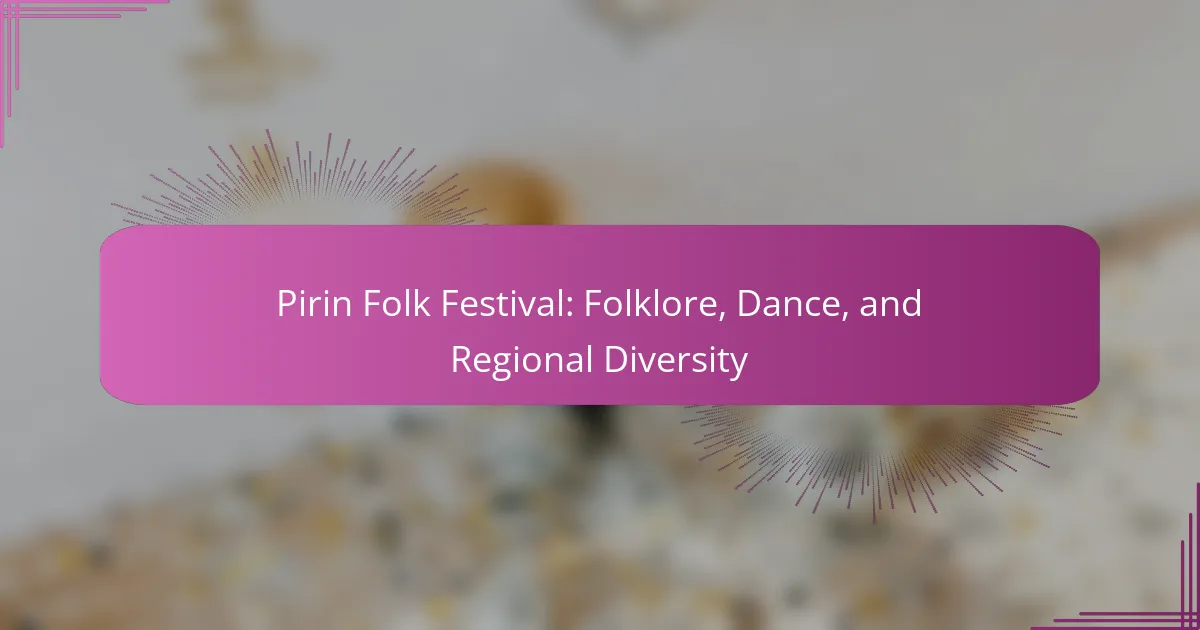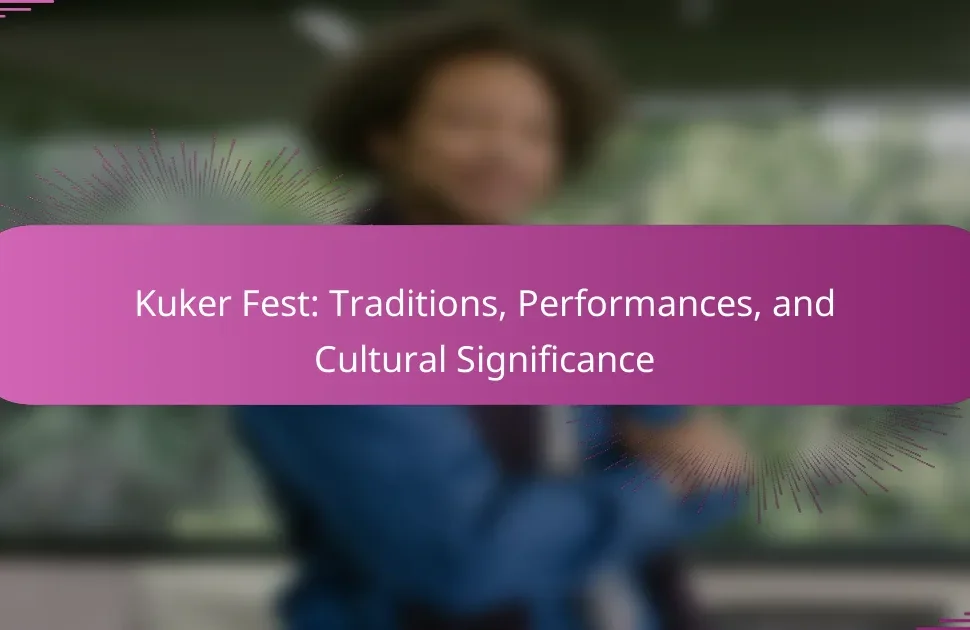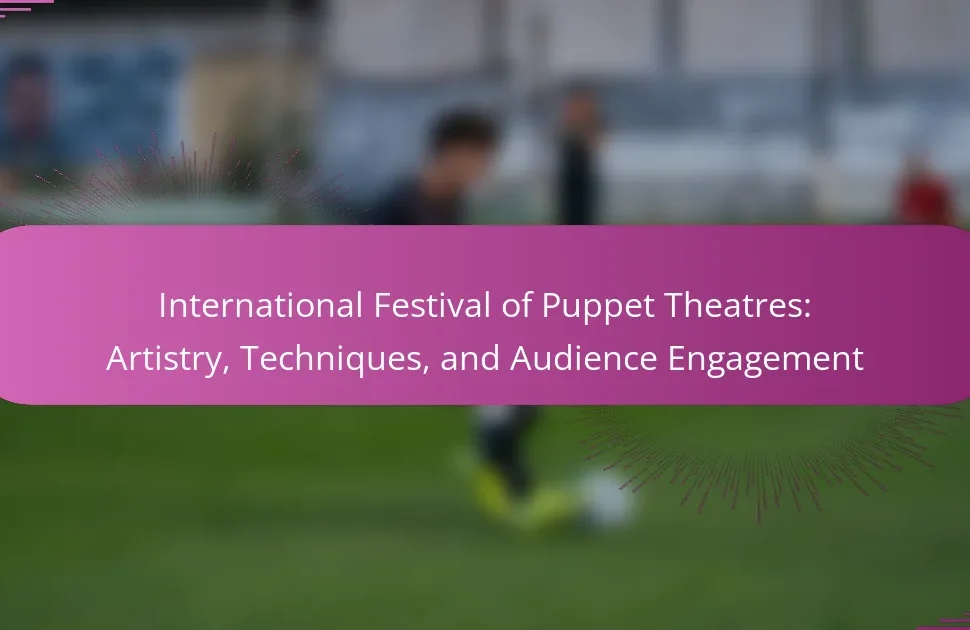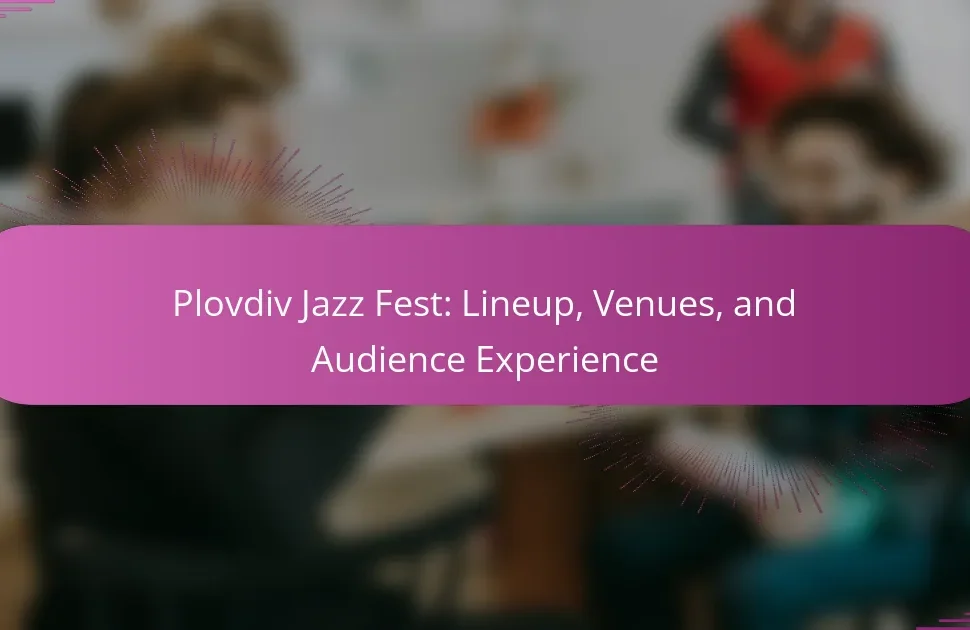The Pirin Folk Festival offers a vibrant celebration of Bulgaria’s diverse cultural heritage through folklore, traditional dance, and regional customs. This article explores the festival’s unique dances, the promotion of regional diversity, and the challenges of cultural preservation. Attendees will discover ways to engage with performances, local crafts, and authentic cuisine, enhancing their appreciation for this rich cultural event.
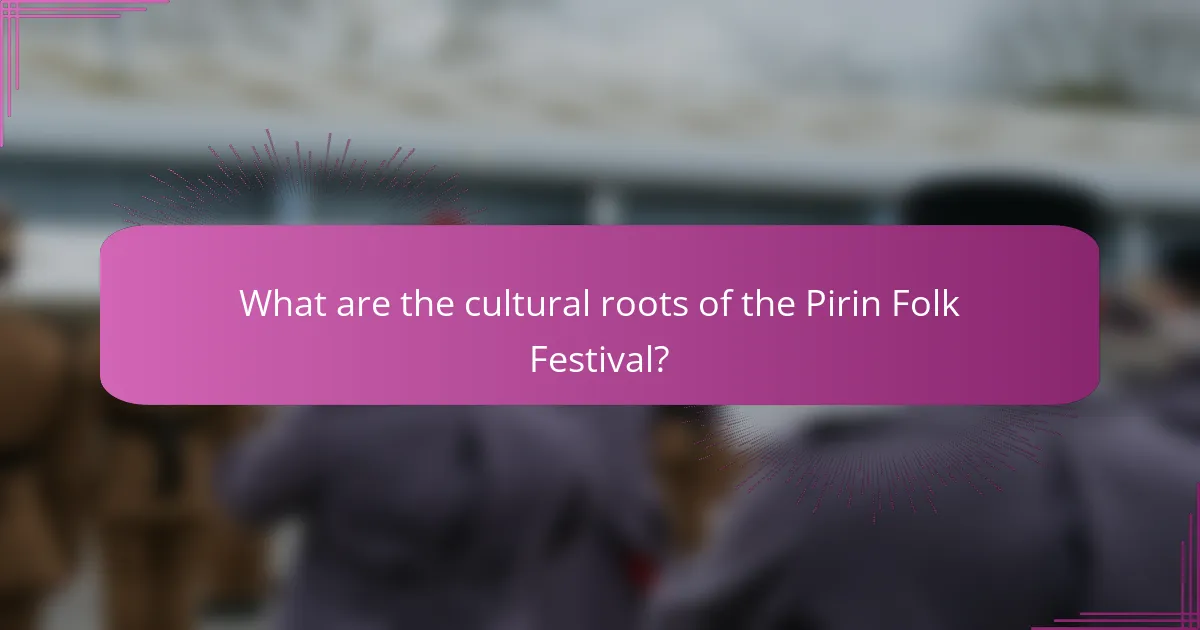
What are the cultural roots of the Pirin Folk Festival?
The Pirin Folk Festival has deep cultural roots in Bulgaria’s Pirin region, showcasing local folklore and traditional dance. This festival celebrates the rich diversity of regional customs, music, and costumes, reflecting the unique heritage of the area. The event features various performances that highlight the distinct dialects and styles of the Pirin Mountains, enriching the cultural tapestry of Bulgaria. By promoting folk traditions, the festival plays a vital role in preserving the region’s identity and fostering community pride.
How does the festival reflect regional folklore traditions?
The Pirin Folk Festival showcases regional folklore traditions through music, dance, and costumes. It features performances that highlight local customs and stories, preserving cultural heritage. Traditional dances, such as the “horo,” reflect community values and social ties. The festival also serves as a platform for diverse regional groups to share their unique folklore, fostering a sense of unity and pride among participants. This celebration of cultural diversity enriches the understanding of the region’s historical narratives and artistic expressions.
Which instruments are commonly used in performances?
The Pirin Folk Festival commonly features traditional instruments such as the gaida, tambura, kaval, and tupan. These instruments are integral to the festival’s folklore and dance performances, showcasing regional diversity. The gaida, a type of bagpipe, is known for its unique sound, while the tambura, a long-necked lute, adds melodic depth. The kaval, a wooden flute, brings a distinct tonality, and the tupan, a drum, provides rhythmic foundation. Together, they create an authentic cultural experience that highlights the rich musical heritage of the region.
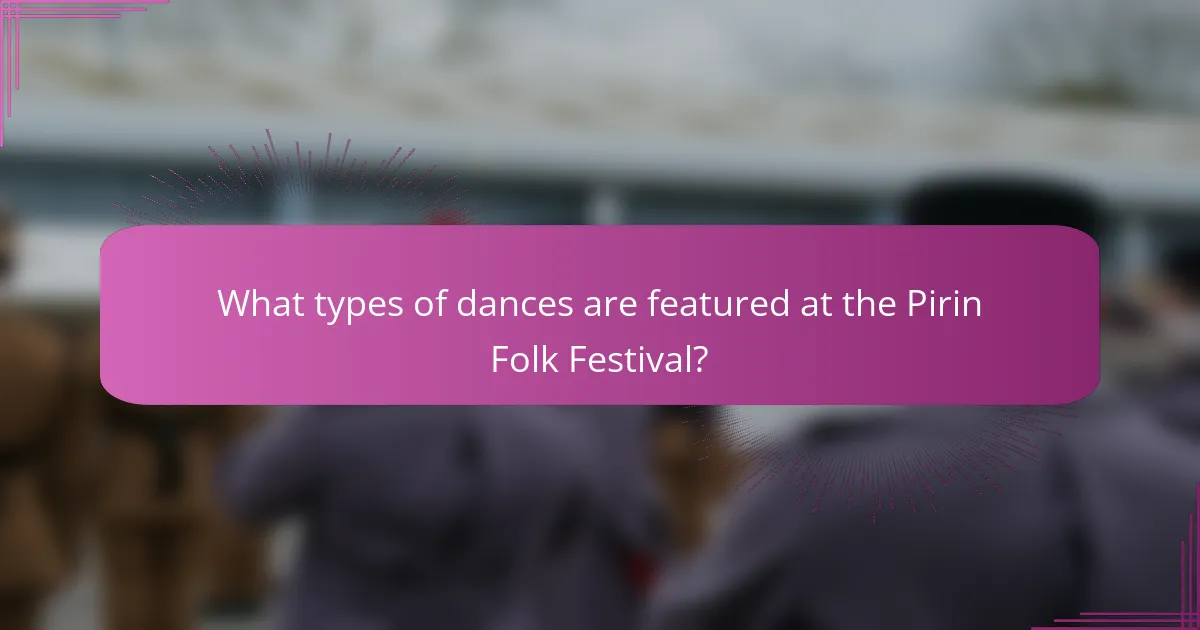
What types of dances are featured at the Pirin Folk Festival?
The Pirin Folk Festival features a variety of traditional Bulgarian dances. These include the Horo, a circle dance that emphasizes community participation, and the Rachenitsa, known for its lively rhythm. Other dances showcase regional styles, such as the Pravo Horo from the Thracian region and the Kopanitsa from the Pirin region. Each dance reflects the cultural diversity and heritage of Bulgaria, highlighting unique movements and costumes.
How do traditional dances vary across different regions?
Traditional dances vary significantly across regions, reflecting cultural diversity and local heritage. In the Pirin Folk Festival, dances showcase unique styles, rhythms, and costumes specific to the region. For instance, the Pirin region features the “Horo,” a circle dance characterized by intricate footwork and communal participation. In contrast, the Rhodope region emphasizes slower, more expressive dances that highlight storytelling. Each dance embodies the community’s history and traditions, making them vital to regional identity. Additionally, local instruments, such as the gaida or kaval, accompany these dances, further enriching the experience. Overall, traditional dances serve as a vibrant expression of cultural diversity across different regions.
What role does choreography play in storytelling during the festival?
Choreography plays a vital role in storytelling at the Pirin Folk Festival by conveying cultural narratives through movement. Each dance performance reflects regional traditions, emotions, and historical events, allowing audiences to connect with the stories being told. The synchronization of dancers enhances the visual impact, making the folklore more engaging. Additionally, unique choreography styles represent distinct local identities, showcasing the diversity of the region’s cultural heritage. This dynamic expression not only entertains but also educates attendees about the significance of folklore in the community.
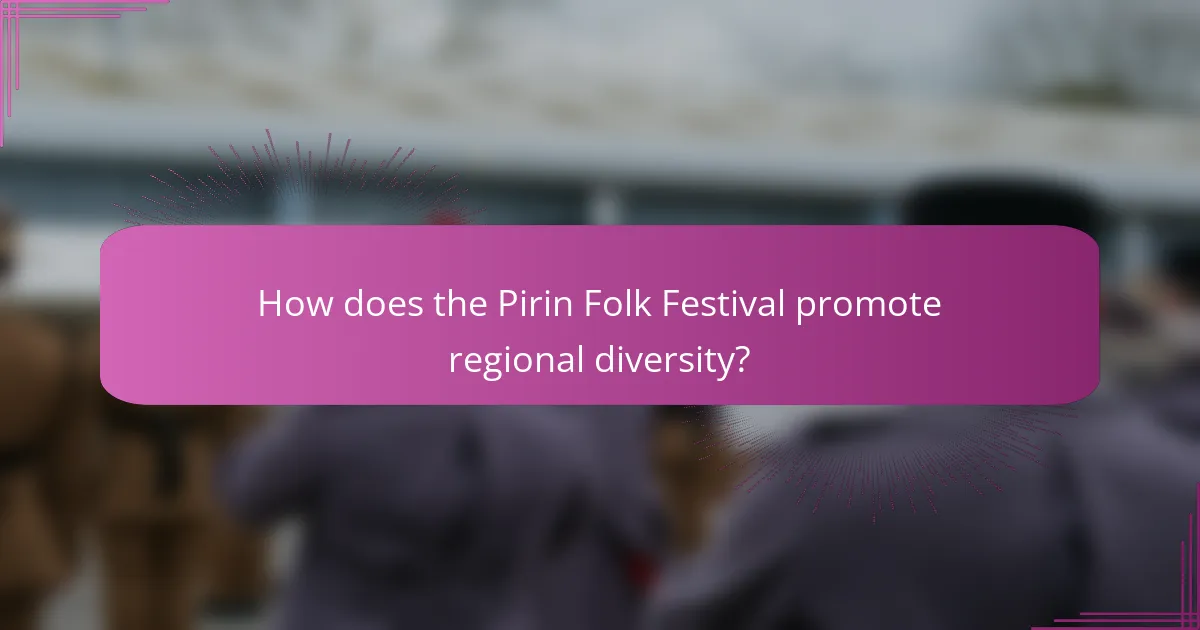
How does the Pirin Folk Festival promote regional diversity?
The Pirin Folk Festival promotes regional diversity by showcasing various local traditions, music, and dance forms. It celebrates the unique cultural heritage of the Pirin region, fostering community pride and intercultural exchange. The festival features performances from different ethnic groups, highlighting their distinct folklore and artistic expressions. As a result, attendees gain insight into the rich tapestry of regional identities, enhancing appreciation for cultural diversity.
Which communities participate and showcase their heritage?
The Pirin Folk Festival features communities from Bulgaria, showcasing their rich folklore and dance traditions. Participants include the local populations of Blagoevgrad, Razlog, and other nearby regions. Each community presents unique cultural expressions, reflecting their heritage through music, costumes, and traditional dances. The festival promotes regional diversity, allowing visitors to experience a vibrant tapestry of Bulgarian culture.
How does the festival foster cultural exchange among attendees?
The Pirin Folk Festival fosters cultural exchange by bringing together diverse traditions from various regions. Attendees experience a rich tapestry of folklore, music, and dance that represents different cultural heritages. This interaction promotes understanding and appreciation of regional diversity. Workshops and performances encourage participation, allowing visitors to engage directly with the culture. As a result, the festival serves as a vibrant platform for dialogue and connection among attendees.
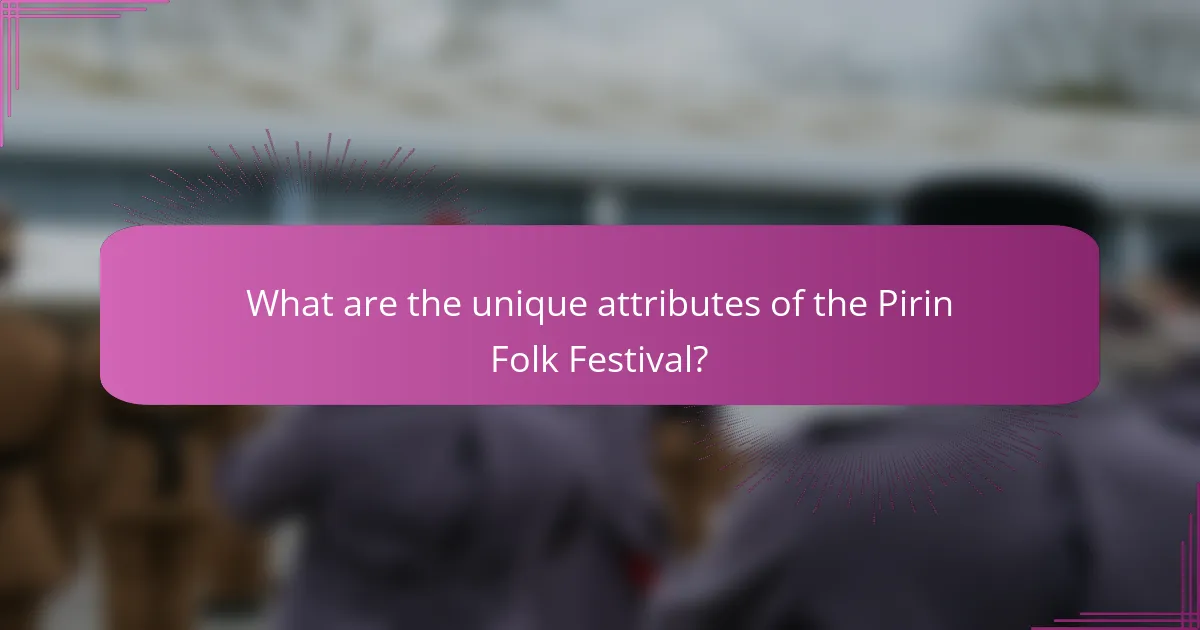
What are the unique attributes of the Pirin Folk Festival?
The unique attributes of the Pirin Folk Festival include its vibrant folklore, diverse regional dances, and the celebration of traditional crafts. The festival showcases unique performances that highlight the cultural heritage of the Pirin region. Each year, it attracts performers and visitors, fostering community engagement and preserving local traditions. The festival’s emphasis on authenticity distinguishes it from other cultural events, allowing for an immersive experience of Bulgarian folklore.
What distinguishes the festival from other cultural events in the region?
The Pirin Folk Festival stands out due to its deep emphasis on regional folklore and diverse cultural expressions. Unlike other cultural events, it showcases authentic traditional music, dance, and costumes unique to the Pirin region. The festival fosters community engagement, featuring local performers and artisans, creating a vibrant atmosphere of cultural pride. Additionally, it offers workshops that educate attendees on folk traditions, enhancing its role as a cultural preservation initiative. This unique focus on interactive experiences and regional specificity sets the Pirin Folk Festival apart from other events.
How do local customs influence the festival’s programming?
Local customs significantly shape the programming of the Pirin Folk Festival. Regional traditions influence the selection of performances, dance styles, and musical genres showcased. For example, specific dances may highlight unique cultural narratives or historical events relevant to the local community. Additionally, local artisans often display crafts that reflect the region’s heritage, enriching the festival experience. This integration of customs fosters a deeper connection between participants and their cultural identity, enhancing the festival’s authenticity and appeal.
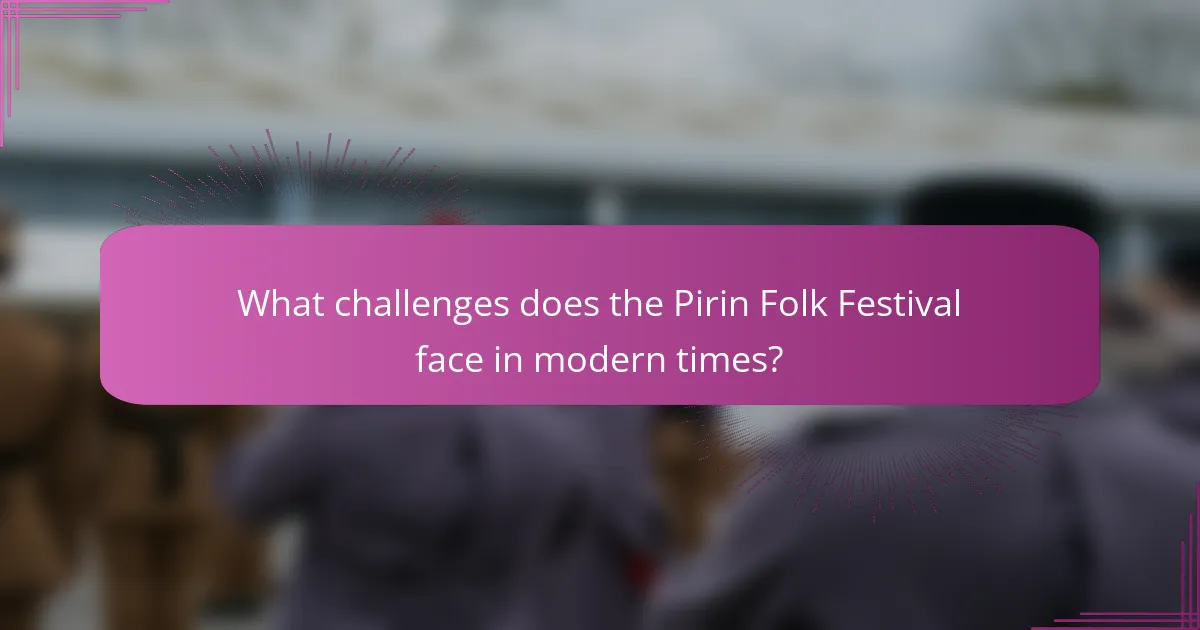
What challenges does the Pirin Folk Festival face in modern times?
The Pirin Folk Festival faces challenges such as modernization, cultural preservation, and audience engagement. As society evolves, traditional practices risk fading. Balancing contemporary influences with authentic folklore remains crucial. Additionally, attracting younger generations is vital for sustaining interest in regional diversity.
How are traditional practices maintained amidst globalization?
Traditional practices, such as those showcased at the Pirin Folk Festival, are maintained through active community engagement and cultural preservation efforts. Local artists and performers play a vital role in keeping folklore and regional dance alive, adapting them to contemporary contexts while honoring their roots.
The festival serves as a platform for intergenerational knowledge transfer, where elders share traditional practices with younger generations. This fosters a sense of identity and belonging, reinforcing community ties amidst globalization’s pressures.
Moreover, cultural tourism promotes awareness and appreciation of regional diversity, encouraging locals to sustain their unique traditions. As a result, traditional practices evolve without losing their core essence, ensuring their survival in a globalized world.
Ultimately, the Pirin Folk Festival exemplifies how cultural heritage can thrive through community involvement, education, and tourism, balancing tradition with modern influences.
What strategies are being implemented to attract younger audiences?
The Pirin Folk Festival attracts younger audiences by incorporating modern elements into traditional performances. Innovative marketing strategies leverage social media platforms to engage youth. Collaborations with contemporary artists and interactive workshops enhance participation. Additionally, the festival offers diverse food options and activities that appeal to younger demographics.
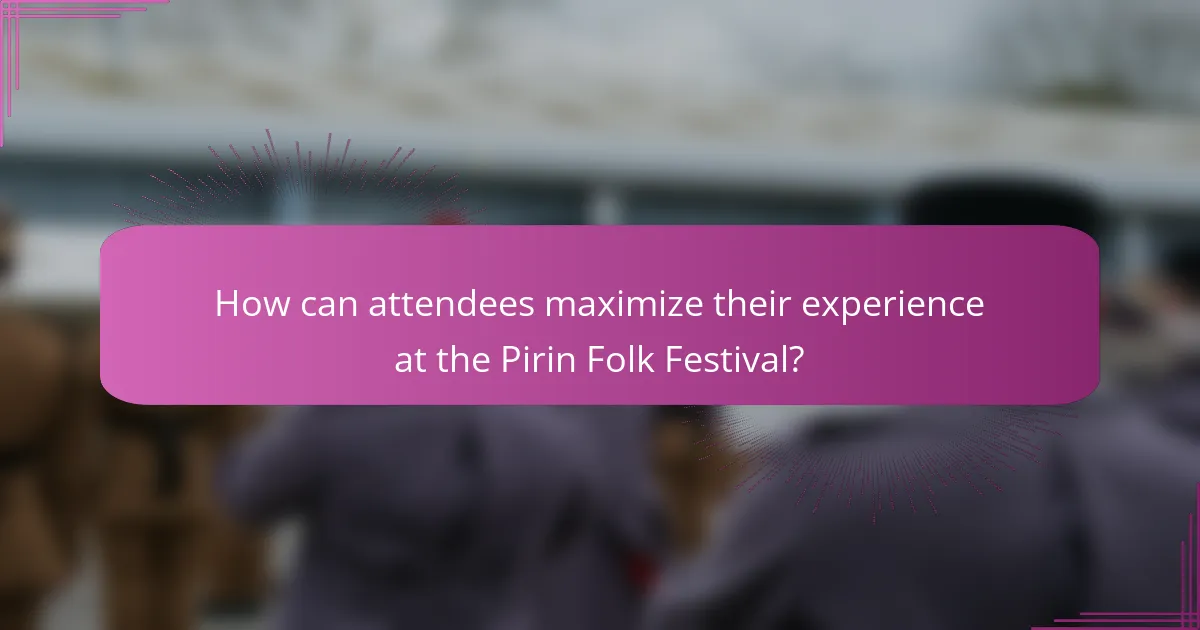
How can attendees maximize their experience at the Pirin Folk Festival?
Attendees can maximize their experience at the Pirin Folk Festival by engaging with the performances, exploring local crafts, and participating in workshops. Embrace the diverse folklore and dance styles showcased, which reflect the region’s cultural richness.
1. Attend performances to appreciate traditional music and dance.
2. Explore artisan booths for unique crafts and souvenirs.
3. Participate in workshops to learn folk dance and music techniques.
4. Taste local cuisine to experience authentic regional flavors.
5. Interact with performers to gain insights into their cultural heritage.
What are the best practices for engaging with performers and artisans?
Engaging with performers and artisans at the Pirin Folk Festival involves fostering collaboration and mutual respect. Prioritize clear communication to understand their needs and artistic vision.
Encourage participation by creating inclusive spaces for dialogue and feedback. Offer fair compensation for their work, recognizing their expertise and contributions.
Promote cultural exchange by showcasing diverse performances and encouraging interactions among different artists. This enhances the festival’s regional diversity and enriches the audience’s experience.
Support continuous learning by providing workshops or training sessions, allowing artisans to develop their skills further. This commitment to growth benefits both the performers and the festival’s reputation.
Which common mistakes should visitors avoid during the festival?
Visitors should avoid common mistakes like neglecting local customs, overpacking, and missing out on key performances. Understanding regional etiquette enhances the experience. Arriving early helps secure good viewing spots for popular dance events. Lastly, staying hydrated is crucial, as festivals can be physically demanding.
What expert tips can enhance the overall festival experience?
To enhance the overall experience at the Pirin Folk Festival, attendees should focus on preparation, engagement, and exploration. Arrive early to secure optimal viewing spots for performances. Participate in workshops to learn traditional dances and crafts, deepening your connection to the region’s folklore. Sample local cuisine to fully appreciate the diverse cultural offerings. Engage with performers and locals to enrich your understanding of the festival’s significance. Finally, explore the surrounding nature for a complete experience of the region’s beauty.
